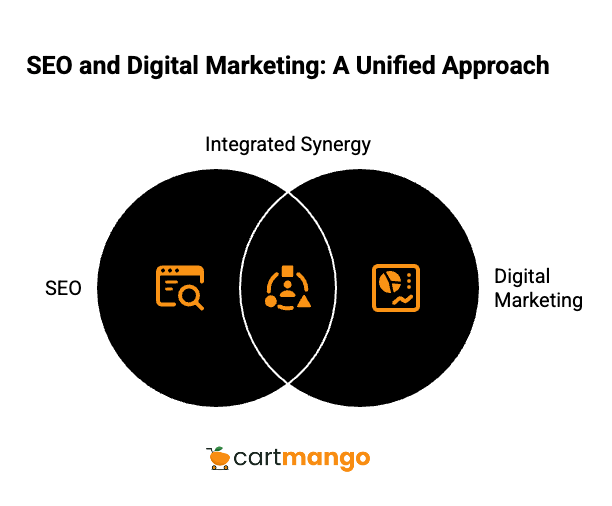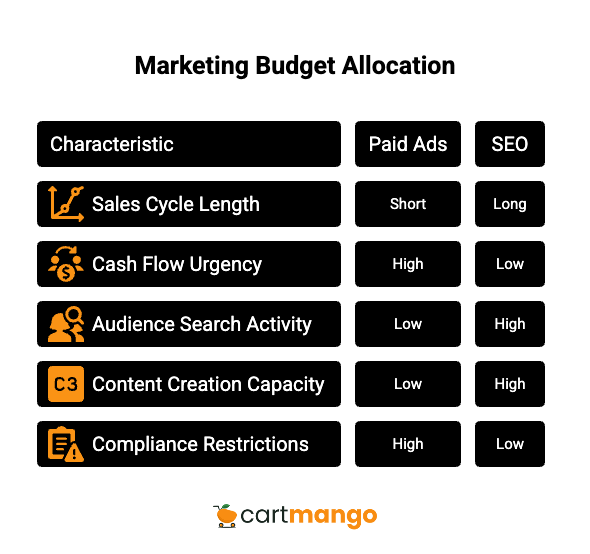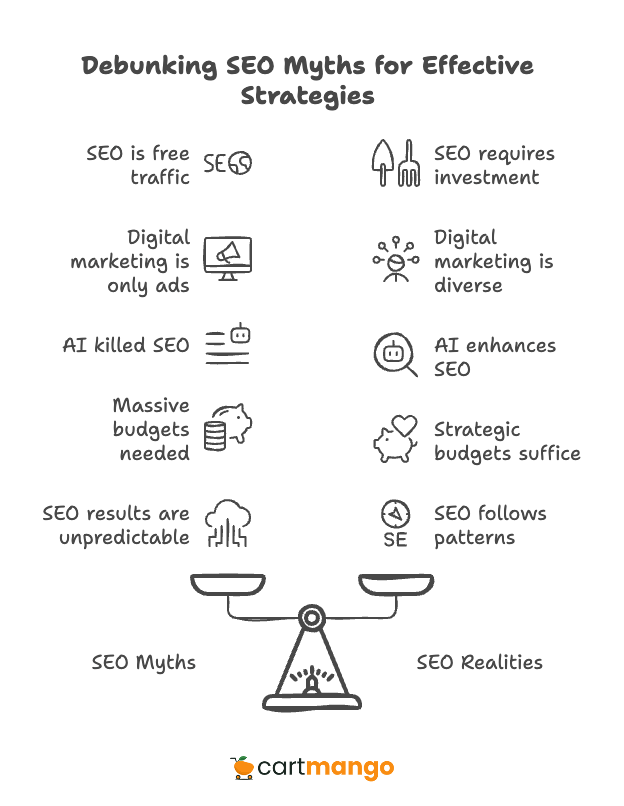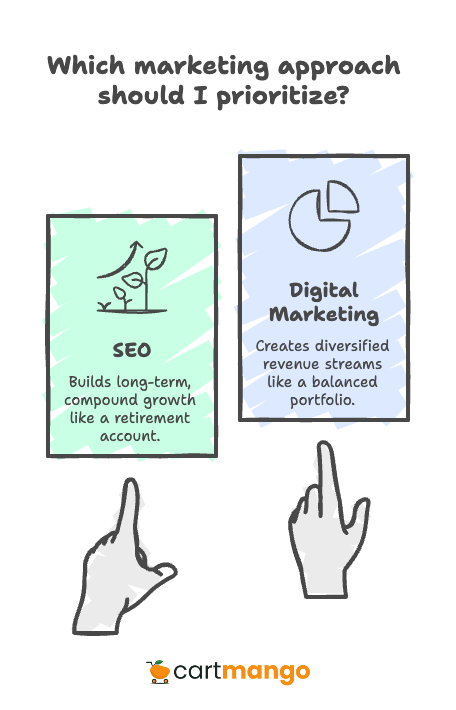For the seo-only 6-month roadmap, jump to this section.
For the digital marketing-only 6-month roadmap, go here.
–
Picture this: Sandra owns a small flower shop in Denver.
She’s staring at her monthly marketing budget of $1,800, torn between two choices. Should she hire someone to optimize her website for Google searches? Or should she jump into paid ads and social media marketing?
This dilemma keeps countless business owners awake at night. Some bet everything on SEO and waited eight months for their first organic lead. Others burned through ad budgets in weeks with nothing to show for it.
By the end of this post, you’ll have a clear comparison matrix and two realistic 6-month roadmaps to pick from. No more guessing games. No more wasted money on strategies that don’t fit your business.
According to BrightEdge research, 53% of online experiences start with a search engine. But here’s what that statistic doesn’t tell you: how long those customers take to convert, what they do after that initial search, and whether they’re ready to buy or just browsing.
SEO vs Digital Marketing At A Glance
Factor | SEO | Full Digital-Marketing Mix | What This Means |
|---|---|---|---|
Primary Goal | Long-term “free” search traffic | Reach, engage & convert via multiple channels (ads, email, social, content, influencer) | Your core objective |
Key Channels | Technical SEO, on-page optimization, content hubs, backlinks | Paid search & social (PPC), organic social, email automation, content marketing, affiliate, influencer, display/video | Where the work happens |
Typical Cost Horizon | Front-loaded labor & tools; moderate upkeep | Continuous ad budget + content & platform fees (email, CRM) | When and how long you pay |
Time to Break-Even | 6-12 months (compounding) | Ads: days-weeks; email/content: 1-3 months | How soon revenue covers cost |
Core KPIs | Organic sessions, keyword rankings, share of voice (SOV) | ROAS, CPL, CAC, open/click rates, social engagement | How success gets measured |
Acronym decoder:
- PPC = Pay-Per-Click
- CRM = Customer Relationship Management
- ROAS = Return on Ad Spend
- CPL = Cost per Lead
- CAC = Customer Acquisition Cost
Google’s Search Central guide breaks down SEO basics if you want to dive deeper into the technical side.
Why “Versus” Is the Wrong Question

Here’s where most people get confused. SEO isn’t fighting against digital marketing. SEO lives inside digital marketing like a puzzle piece in a bigger picture.
Think of it this way: if digital marketing is your entire toolkit, SEO is one of your most important tools. You wouldn’t ask “hammer versus toolbox” because the hammer belongs in the toolbox.
The overlap happens everywhere. Your SEO content feeds your social media posts. Your paid ads drive traffic that helps your email list grow. Your email campaigns can link back to your SEO-optimized blog posts.
Many folks learned this the hard way when they tried to run SEO and paid ads as completely separate campaigns. The messaging was inconsistent. The landing pages looked different. Customers got confused about what their business actually offered.
Smart companies treat them as dance partners, not competitors. When someone clicks your Google ad, they often check your organic rankings to validate your credibility. When they find you through organic search, they might see your retargeting ads later that day.
Smart companies weave SEO into their content strategy instead of treating them as separate activities.
Pros and Cons
SEO Pros:
- Compounds over time (month 12 traffic beats month 1 by massive margins)
- Builds long-term credibility and trust
- Lower cost per click once you rank
- Works 24/7 without ongoing ad spend
- Customers trust organic results more than ads
- One piece of content can drive traffic for years
SEO Cons:
- Painfully slow to start (you’ll question everything for months)
- Algorithm changes can wreck your rankings overnight
- Requires consistent content creation and technical maintenance
- Results depend on Google’s mood swings
- Competitive keywords can take years to rank for
- No guaranteed traffic volume or timeline
Digital Marketing Mix Pros:
- Immediate visibility and traffic
- Precise targeting (age, location, interests, behaviors)
- Easy to test and optimize quickly
- Multiple channels reduce risk
- Predictable traffic volume for budget planning
- Can target competitors’ customers directly
Digital Marketing Mix Cons:
- Costs never stop (turn off ads, traffic disappears)
- Ad fatigue hits your audiences over time
- Privacy changes keep breaking your tracking
- Competition drives costs up every year
- Platform dependencies (Facebook changes rules, you adapt)
- Creative demands are constant
SEO leads close at 14.6% compared to just 1.7% for outbound marketing tactics (Source: Intergrowth). That’s a massive difference in conversion quality.
But here’s the thing: you can pair SEO with retargeting ads to slash your cost per click. When someone visits your organic content first, they’re warmer prospects for your paid campaigns.
I’ve seen businesses reduce their Facebook ad costs by 40% just by retargeting people who read their blog posts first. The organic content pre-sells the product. The ads close the deal.
Shopify’s guide to e-commerce SEO shows how smart online stores combine organic rankings with strategic paid product ads during launches.
5 Questions That Determine Your Budget Split
Stop guessing. Answer these five questions and you’ll know how to allocate your marketing dollars:

Question 1: How long is your sales cycle?
If people buy from you within days of discovering you, paid ads make sense. If they research for months before buying, SEO builds that long-term relationship.
Example: A wedding photographer has a 3-6 month sales cycle. Couples research extensively before booking. SEO captures them early in their journey. A pizza restaurant has a same-day sales cycle. Paid ads for “pizza delivery near me” work better.
Question 2: How urgent is cash flow?
Drowning in bills? You need paid ads to generate revenue fast. Comfortable runway? SEO’s long-term compound growth pays better dividends.
I’ve seen too many businesses choose SEO when they needed immediate cash. They ran out of money before seeing results. Be honest about your financial situation.
Question 3: Is your audience actively searching?
If your customers Google problems you solve, SEO captures that intent. If they don’t know they need you yet, interruption marketing (ads, social) works better.
Test this: Go to Google and type what you think your customers search for. Are there results? Are competitors advertising? High search volume plus ads means proven demand.
Question 4: Do you have content bandwidth?
SEO demands consistent, quality content creation. If you’re already stretched thin, paid ads might be more realistic for your current capacity.
Content creation takes time. A 1,000-word blog post requires research, writing, editing, and optimization. Budget 4-6 hours per post if you’re doing it yourself. Outsourcing costs $200-500 per post for quality work.
Question 5: Any compliance limits?
Industries like healthcare, finance, and legal face strict advertising regulations. SEO often provides a cleaner path to visibility without regulatory headaches.
Meta could reject an addiction treatment center’s ads. Same content ranked on Google organically without issues. Know your industry’s advertising restrictions.
Busting the Myths That Cost You Money
These misconceptions lead to poor decisions and wasted budgets.

Myth 1: “SEO is free traffic”
Wrong. SEO requires time, tools, and talent. A skilled SEO specialist can cost $75-150 per hour. Quality content creation costs $0.50-2.00 per word. SEO tools run $100-500 monthly. Free traffic isn’t free.
The “free” part only applies after you’ve invested months of work and thousands of dollars in development. Even then, you need ongoing maintenance and content creation.
Myth 2: “Digital marketing equals only paid ads”
This narrow view ignores email marketing, content marketing, social media, influencer partnerships, affiliate programs, and PR outreach.
Paid ads are just one piece of the puzzle.
Some of the most successful digital marketing campaigns I’ve seen used zero paid advertising. They relied on email sequences, social media engagement, and strategic partnerships.
Myth 3: “AI killed SEO”
Search volume keeps growing every year. People still Google billions of queries daily. AI changes how we create content, but it doesn’t eliminate the need for discovery.
Google’s Search Generative Experience (SGE) provides AI-powered answers, but people still click through to websites for detailed information and purchasing decisions.
Myth 4: “Running ads hurts your organic rankings”
Google’s algorithm doesn’t penalize you for advertising. Your organic rankings depend on content quality, technical performance, and user experience. Ads and SEO operate in separate systems.
The two channels reinforce each other by increasing brand recognition.
Myth 5: “You need massive budgets to compete”
Small businesses can compete with smart targeting and local focus. A $500 monthly budget can outperform a $5,000 budget if it’s spent strategically.
The key is knowing your audience better than bigger competitors do. Local knowledge, personal relationships, and niche expertise can beat big budgets when applied correctly.
Myth 6: “SEO results are unpredictable”
While you can’t guarantee specific rankings, SEO follows predictable patterns.
Quality content, technical optimization, and consistent effort produce measurable improvements over time.
The businesses that call SEO “unpredictable” usually lack proper tracking and realistic expectations. Set up proper analytics and track progress monthly, not daily.
Companies worldwide spend a massive $1.16 trillion on advertising in 2025, showing just how much businesses invest in marketing to reach customers and drive sales (Source: Statista).
AI tools are changing search marketing tactics, not eliminating the need for search marketing altogether.
Your SEO-Only Roadmap (6 Months, No Hype)
Now that you understand the reality behind SEO vs digital marketing, here’s a practical month-by-month SEO plan. I’m not promising overnight success because that’s not how this works.
Month | Core Task | KPI Target | Who Does It | Key Terms |
|---|---|---|---|---|
0-1 | Technical audit & quick fixes | Indexation ≥ 95% | SEO specialist | Indexation = % of pages Google can crawl |
1-2 | Keyword research & content mapping | 50 priority terms identified | Content team | – |
2-3 | Publish 10 core cluster posts (1,000 words each) | 10 live URLs | Content team | URL = page address |
3-4 | On-page optimization & internal linking | Bounce rate ↓ 10% | SEO specialist | Bounce = single-page visit |
4-5 | Backlink outreach (podcasts, guest posts) | +20 referring domains | Outreach lead | Domain = unique website |
5-6 | Schema markup & UX improvements | Rich snippet CTR +2 percentage points | SEO specialist | CTR = Click-Through Rate |
Month 0-1 Reality Check:
Your technical audit will uncover problems. Slow loading speeds. Broken links. Missing meta descriptions. Poor mobile experience. Fix the biggest issues first. Don’t try to perfect everything.
Month 1-2 Keyword Strategy:
Research tools like Semrush or Ahrefs cost $100-300 monthly. Free alternatives include Google Keyword Planner. Focus on search volume above 50 and competition below 50.
Month 2-3 Content Production:
Ten posts in one month is aggressive but doable. Each post should target one primary keyword and 2-3 related terms. Quality beats quantity. One excellent post outperforms five mediocre ones.
Month 3-4 Optimization Work:
On-page SEO includes title tags, meta descriptions, header structure, and internal linking. This technical work often gets skipped, but it’s crucial for ranking improvements.
Month 4-5 Link Building:
Backlinks remain a top ranking factor. Reach out to podcasts in your industry. Write guest posts for relevant blogs. Partner with complementary businesses. Quality beats quantity here too.
Month 5-6 Advanced Features:
Schema markup helps search engines understand your content better. Rich snippets increase click-through rates. User experience improvements reduce bounce rates and increase engagement.
The first three months will feel like you’re shouting into the void. That’s normal. Month 4 is when you’ll start seeing small wins. Month 6 is when the momentum builds.
Your Digital Marketing-Only Roadmap (6 Months, Realistic Expectations)
Maybe you decided SEO moves too slow for your situation. Here’s how to build a diversified digital marketing approach without burning cash:
Month | Core Task | KPI Target | Who Does It | Key Terms |
|---|---|---|---|---|
0-1 | Launch Google Search Ads | CTR ≥ 3% | PPC specialist | CTR = Click-Through Rate |
1-2 | Add social ads + site retargeting | First 100 conversions | Marketing team | Conversion = desired action (sale/lead) |
2-3 | Build & segment email list | 1,000 subscribers | Email specialist | – |
3-4 | Influencer partnerships + content repurposing | 15 backlinks, 5 collaborations | PR lead | Backlink = external link to your site |
4-5 | Creative testing & bid optimization | ROAS ≥ 2.5 | Marketing analyst | ROAS = Return on Ad Spend |
5-6 | Test display & video ads | Brand awareness baseline | Campaign manager | Brand lift = awareness increase |
Month 0-1 Paid Search Setup:
Start with Google Ads search campaigns. Target your exact match keywords. Set daily budgets around $50-60 to control spending. Write compelling ad copy that matches your landing pages.
Month 1-2 Social Expansion:
Facebook and Instagram ads work well for visual products. LinkedIn ads work for B2B services. Test different audiences and ad formats. Retargeting ads target people who visited your website.
Month 2-3 Email Foundation:
Email marketing still delivers $42 return for every $1 spent. Create lead magnets to capture emails. Segment subscribers based on interests and behaviors. Automate welcome sequences.
Month 3-4 Content Partnerships:
Influencer partnerships don’t require huge budgets. Micro-influencers (10K-100K followers) often trade products for posts. Guest posting on relevant blogs builds backlinks and credibility.
Month 4-5 Optimization Phase:
Test different ad creatives, audiences, and landing pages. A/B test email subject lines and content. Optimize your highest-performing campaigns and pause underperformers.
Month 5-6 Channel Expansion:
Display ads and video ads help with brand awareness. YouTube ads can be cost-effective for certain audiences. Test new platforms carefully with small budgets first.
Month 1 will give you immediate feedback about what works. Month 2-3 builds your owned media assets. Month 4-6 optimizes for profitability and scale.
The key difference: you’ll see results faster but need to keep feeding the machine with ad spend. Turn off the budget, traffic disappears.
Understanding How Search Engines Work (And Why It Matters)
Before you dive deeper into your chosen approach, let’s talk about what happens behind the scenes. Search engine optimization isn’t just about throwing relevant keywords at a web page and hoping for the best.
Search engines work through complex search algorithms that evaluate hundreds of factors. These search engine algorithms determine how search engine results pages display your content to users when they search for something you offer.
Here’s what search engines actually look for:
Technical Elements:
- Website loading speed
- Mobile responsiveness
- Internal and external links structure
- Technical aspects of your site’s code
Content Quality:
- Valuable content that answers what users search for
- Website content that matches search intent
- Keyword optimization that feels natural

Search engine marketing and search engine optimization seo both aim to improve your website’s visibility in search engine results. The difference? SEO focuses on organic search results while search engine marketing includes paid search results too.
When you understand how search engines work, your seo efforts become more strategic. You stop guessing and start optimizing websites based on what actually moves the needle.
Achieving seo success requires attention to both the technical elements and the quality of your website content. Without this balance, your website’s ranking will struggle to improve.
Essential Tools and Metrics for Success
Whether you choose SEO or broader digital marketing, you need the right tools to measure what’s working. Here are the must-haves that marketing professionals rely on:
- Tracks website traffic from all online channels
- Shows which marketing efforts drive the most potential customers
- Measures how well you increase organic traffic over time
- Monitors your website’s ranking in search results
- Identifies technical issues affecting your search engine ranking
- Shows which relevant keywords bring visitors to your site
PPC Advertising Platforms:
- Google Ads for search and display campaigns
- Social media platforms for targeted advertising
- Tools to manage digital advertising spend and performance
The key is connecting these tools to create a complete picture. Your Google Analytics might show that organic traffic increased 40% last month. But without Google Search Console, you won’t know which seo strategies actually moved your website’s ranking.
Most businesses make the mistake of tracking vanity metrics instead of what matters. Focus on metrics that directly connect to revenue: qualified leads, conversion rates, and customer acquisition costs.
Using these tools effectively is a critical part of any effective digital marketing strategy. They help you understand your digital presence and adjust your marketing strategies based on real data.
Building Your Long-Term Digital Presence
Here’s where seo and digital marketing truly work together. Your digital presence isn’t just about individual tactics. It’s about creating a long term strategy that builds on itself.
Digital marketing includes everything from your website seo to how you engage on social media platforms. An effective digital marketing strategy treats each online channel as part of a bigger system.
Your Foundation:
- Website’s visibility in organic search results
- Technical optimization that helps you rank higher
- Off page optimization through partnerships and backlinks
Your Growth Engine:
- Content that helps increase brand awareness
- Social media presence that amplifies your reach
- Email marketing that nurtures relationships
Your Expansion:
- PPC advertising to fill gaps while organic growth builds
- Partnerships that raise brand awareness in new markets
- Online marketing campaigns that generate leads immediately
Your target audience doesn’t care whether they found you through organic traffic or paid ads. They care about solving their problems. That’s why both digital marketing approaches work best when they support the same core message.
SEO vs Digital Marketing: Choose Which?

Here’s what I want you to remember:
- SEO builds compound growth like a retirement account.
- Digital marketing creates diversified revenue streams like a balanced portfolio.
You don’t have to choose just one forever. Start with whichever approach fits your current situation better. Build competence there first. Then layer in the other approach once you have stable systems.
Sarah, the florist I mentioned earlier? She started with local SEO because her customers were searching for “flower delivery Denver” and “wedding florist near me.” Six months later, she added targeted Facebook ads for seasonal promotions.
Your situation is different. Your audience is different. Your resources are different. But the framework stays the same: match your approach to your reality, not someone else’s success story.
If you’re still uncertain, consider this simple test:
- Can you afford to wait 6-12 months for results? If yes, try SEO first.
- If no, start with paid marketing to generate immediate revenue, then reinvest profits into SEO.
The businesses that thrive long-term use both approaches strategically. They understand that SEO provides the foundation while paid marketing accelerates growth and fills gaps.
Most successful companies follow this pattern: Start with one approach, master it, then gradually add complementary channels. Trying to do everything at once usually leads to mediocre results across all channels.
Related
- SendOwl vs SamCart: The Recurring Revenue Jail (2026)
- ThriveCart vs ClickFunnels: When more features hurt (2026)
- SendOwl vs Payhip: The “You-Leave-You-Lose” Model (2026)
- SamCart vs Kajabi: The Income Hostage Trap (2026)
- Sellfy vs Payhip: The Recurring Revenue Prison (2026)
- Podia vs Gumroad: The Recurring Revenue Handcuffs (2026)
- SendOwl vs Gumroad: The Recurring Revenue Black Hole (2026)
- Gumroad vs Sellfy: The Vendor Lock-in Cage (2026)
- Gumroad vs Payhip: The Hidden Trap for Creators (2026)
- ThriveCart vs SamCart – The Subscription Hostage Trap (2026)
